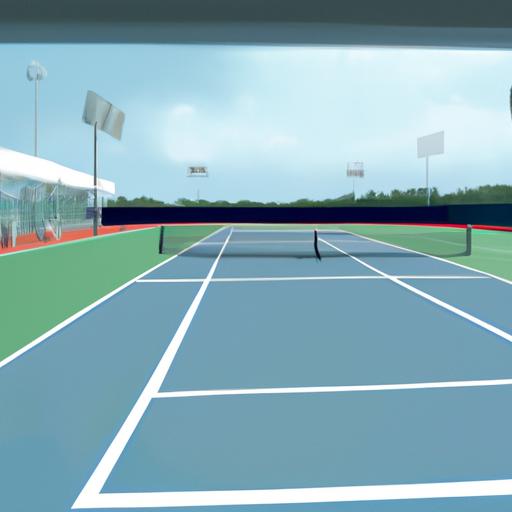If you’re a tennis player or tennis court owner, you know how important it is to maintain a well-kept court.
Ensuring your court is in top condition means taking the necessary steps to keep it in great shape, including tennis court resurfacing.
But what is tennis court resurfacing and how is it done? In this step-by-step guide, we’ll cover all the essential topics of tennis court resurfacing, from why it’s necessary and the materials used to the process and benefits.
We’ll also provide some helpful preparation tips for an optimal resurfacing job.
Let’s dive in and get started!
Table of Contents
Short Answer
Tennis court resurfacing is the process of restoring a tennis court’s playing surface.
It typically involves removing the existing surface, repairing any damaged areas, and laying down a new surface.
The new surface material can range from acrylic to rubber to clay.
Depending on the type of court, the resurfacing process may also involve painting lines and adding a coating to protect the court from weather damage.
Why Resurfacing a Tennis Court is Necessary
Tennis court resurfacing is an essential part of maintaining the condition of the court and ensuring its longevity.
The process involves grinding down the existing court surface, adding a new layer of asphalt or concrete, and applying an acrylic coating to the surface.
This helps to promote a consistent playing surface that is less prone to wear and tear.
Additionally, it may be necessary to resurface a tennis court if the existing surface has become uneven or cracked, as this can drastically reduce the playability of the court and can lead to injuries if not addressed.
Regular resurfacing of a tennis court can also help to reduce glare caused by the sun, which can be a distraction for players.
Resurfacing can also help to improve the aesthetics of the court, which can be beneficial for both players and spectators.
Types of Tennis Court Surfaces

When it comes to tennis court resurfacing, there are a few different types of surface material that can be used.
The most common types of surfaces are asphalt, concrete, and synthetic turf.
Each type of surface has its own unique benefits and drawbacks, making it important to consider all of the options before choosing a surface for your court.
Asphalt is the most common surface used for tennis courts, due to its affordability and durability.
Its also relatively easy to maintain, although it does require regular re-coating to keep it in good condition.
Asphalt surfaces provide a good balance of speed, spin, and bounce, making them suitable for all types of players.
Concrete is another popular choice for tennis courts, and it can provide a more consistent playing surface than asphalt.
Its also more durable and easier to maintain.
However, it can be more expensive than asphalt and is more prone to cracking and breaking down over time.
Synthetic turf is becoming increasingly popular for tennis courts, as its more affordable and easier to maintain than other surfaces.
It provides a consistent playing surface and is more resistant to weather conditions.
However, it can be less durable than other surfaces and can cause more wear and tear on players shoes.
No matter which surface you choose for your court, its important to ensure that its properly installed and maintained to ensure a safe playing surface.
Tennis court resurfacing can be a big investment, but its worth it for the improved playability and longevity that it can provide.
The Resurfacing Process
When it comes to tennis court resurfacing, the process typically involves several steps.
First, any debris and vegetation must be removed from the court.
This is followed by grinding down the existing court surface to create a level and even playing surface.
Next, a new layer of asphalt or concrete is applied, depending on the type of playing surface desired.
Finally, an acrylic coating is added to the new surface.
This helps to improve the playability of the court and prolong its lifespan.
The type of resurfacing chosen will depend on the court’s condition, as well as the type of playing surface desired.
For instance, if the court is in good condition but needs an upgrade, a thinner layer of asphalt or concrete may be applied.
If the court is in poor condition, a thicker layer of asphalt or concrete may be necessary.
Additionally, if a specific type of playing surface is desired, such as a hard court, the type of resurfacing will need to be tailored to the desired surface.
Tennis court resurfacing is an important part of maintaining a safe and enjoyable playing surface.
It can help to improve the playability of a court and extend its lifespan.
Additionally, resurfacing can help to reduce the risk of injury due to uneven surfaces or poor playing conditions.
By following the steps outlined above, you can ensure that your court is resurfaced properly and is ready for years of enjoyable play.
The Tools and Materials Needed for Resurfacing

When it comes to tennis court resurfacing, it’s important to have the right tools and materials on hand.
Depending on the condition of the court and the type of playing surface desired, you may need to purchase the necessary equipment and materials.
First, you’ll need a power trowel to grind down the existing court surface.
This will allow you to level out the court and create a smooth, even playing surface.
You’ll also need a roller or a squeegee to spread the new layer of asphalt or concrete.
In addition to the power trowel, you’ll need to purchase the materials for the new playing surface.
This may include an acrylic coating, which is applied to the surface to create a durable, smooth, and long-lasting playing surface.
You’ll also need to purchase the asphalt or concrete mix for the new layer.
Finally, you’ll need to purchase the necessary tools and materials for the acrylic coating, such as a paint brush, roller, or squeegee.
In addition, you may also need to purchase a sealer to protect the acrylic coating from the elements and help preserve its durability.
Once you have all of the necessary tools and materials on hand, you can begin the process of resurfacing your tennis court.
The process includes grinding down the existing court surface, adding a new layer of asphalt or concrete, and applying an acrylic coating to the surface.
With the right tools and materials, you can ensure that the process goes smoothly and that your court is restored to its optimal playing condition.
The Benefits of Resurfacing a Tennis Court
Tennis court resurfacing is an important part of maintaining the condition of a court and making sure it is fit for play. Resurfacing a court can have a number of benefits, including:
1. Improved playability Resurfacing a court can improve the playing surface, making it easier to play on, and increasing the enjoyment of the game.
2. Prolonged lifespan A resurfaced court is more durable and can last longer than an un-resurfaced court.
3. Cost savings Resurfacing a court can save money in the long run, as it is usually cheaper than replacing a court entirely.
4. Improved aesthetics A resurfaced court looks better and is more attractive to players.
5. Safer playing surface Resurfacing a court can make it safer for players, as it can reduce the risk of slipping and falling.
Overall, resurfacing a tennis court can provide a range of benefits, making it an important part of maintaining the condition of the court and ensuring it is suitable for play.
Common Problems That May Need Resurfacing

Tennis court resurfacing is often necessary when the playing surface is in need of repair or replacement.
Over time, exposure to the elements and regular wear and tear can cause a court to deteriorate, making it unsafe or unplayable.
Common problems that may need to be addressed with resurfacing include cracks, divots, and puddles.
Cracks, if left untreated, can become deep and potentially pose a hazard for players.
Divots, or indentations in the court surface, can cause an uneven playing surface and lead to an inconsistent bounce of the ball.
Puddles can form due to poor drainage or from rain, causing a slippery court surface and raising the risk of injury.
Resurfacing the court can help to address these issues and restore the court to a playable and safe condition.
Preparation Tips for Resurfacing a Tennis Court
Before beginning any resurfacing project, it is important to properly prepare the surface.
This includes removing any debris, weeds, and other items from the area that could interfere with the work.
Additionally, it is important to check the condition of the existing court surface and make any necessary repairs prior to resurfacing.
Additionally, it is important to make sure that any existing cracks and expansion joints are sealed properly.
This will ensure that the new playing surface adheres correctly to the courts existing surface.
It is also important to check the drainage system of the court, making sure that it is functioning correctly.
Poor drainage can lead to premature deterioration of the courts surface.
Finally, it is important to make sure the surface is level before resurfacing.
A level base is essential for a smooth and even playing surface, and any bumps or uneven areas should be leveled out prior to resurfacing.
Additionally, any existing playing lines should be removed before resurfacing, as they will not be visible once the new surface is in place.
By following these preparation tips, you can ensure that your tennis court resurfacing project goes as smoothly as possible.
With proper preparation, you can ensure that your court looks great and provides a safe and enjoyable playing surface for years to come.
Final Thoughts
With this step-by-step guide, you now have a comprehensive understanding of what tennis court resurfacing is and why it is necessary.
You know the different types of surfaces, the resurfacing process, the tools and materials needed, and the benefits of resurfacing a court.
You also know the common problems that may arise and the tips for preparation.
Now that you have this knowledge, it’s time to put it into practice and resurface your tennis court for improved playability and a longer-lasting court.

